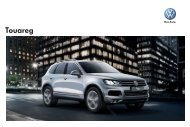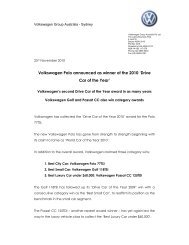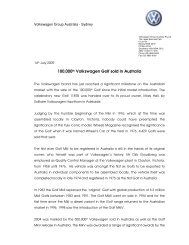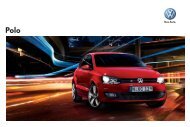Touareg - Volkswagen
Touareg - Volkswagen
Touareg - Volkswagen
Create successful ePaper yourself
Turn your PDF publications into a flip-book with our unique Google optimized e-Paper software.
Brake Assist<br />
During emergency braking, Brake assist aids the driver by<br />
increasing the brake pressure automatically to a level exceeding the<br />
locking limit. The ABS is thus quickly brought into the operating<br />
range, which enables maximum vehicle deceleration to be achieved.<br />
Electronic Differential Lock (EDL)<br />
EDL improves driving and steering characteristics when<br />
accelerating on road surfaces where each wheel has a different<br />
degree of traction. The system operates automatically and is<br />
combined with the ABS system.<br />
Using the ABS wheel sensors, EDL monitors the speed of the<br />
individual driving wheels. When a difference in driving wheel speed<br />
is detected (i.e. when one wheel starts to spin due to differences<br />
in road surfaces, e.g. due to water or dirt) the system brakes the<br />
spinning wheel, transferring engine power to the wheel with the<br />
best traction. EDL is active on both axles in forward and reverse and<br />
operates up to 40km/h.<br />
Anti-Slip Regulation (ASR)<br />
ASR is a switchable traction control system that prevents the wheels<br />
from spinning under acceleration by reducing engine torque. It is<br />
active at speeds above 40km/h.<br />
Electronic Stabilisation Program (ESP)<br />
ABS, EDL and ASR traction control systems are integrated into<br />
the Electronic Stabilisation Program (ESP). In short, ESP helps<br />
ensure that the vehicle goes where you steer it even in extreme<br />
driving conditions. The ESP system constantly compares the actual<br />
movement of the vehicle with pre-determined values and should<br />
a situation arise where the vehicle starts to skid, ESP will apply the<br />
brakes to individual wheels and automatically adjust the engine’s<br />
power output to correct the problem. ESP prevents the vehicle from<br />
losing control when trying to avoid an accident, for example. It also<br />
prevents spinning off on a curve due to either understeer or oversteer.<br />
Engine Braking Control (EBC)<br />
Prevents the driven wheels from locking if the accelerator is lifted<br />
very suddenly or the vehicle is braked sharply because a low gear<br />
is engaged.<br />
Front Assist with emergency brake function<br />
O<br />
The Front Assist ambient traffic monitoring system uses radar<br />
sensors to detect critical distance situations and thus help to shorten<br />
the braking distance, reducing the risk of a rear-end collision.<br />
The traffic ahead is monitored constantly by the radars at the front.<br />
If a vehicle is detected ahead of you in the lane, the distance and<br />
the speed relative to it are calculated. If the gap is closing too fast,<br />
Front Assist initially warns the driver by means of an audible as<br />
well as a visual signal. At the same time, the brake pads are brought<br />
into contact with the brake discs and the sensitivity of the Brake<br />
Assist is increased. This primes the braking system for a possible<br />
emergency stop.<br />
If the situation escalates, the emergency brake function provides<br />
automatic braking and or boosting of the drivers braking force up<br />
to maximum braking.<br />
Front Assist cannot replace the driver’s assertiveness. The driver is still legally<br />
responsible for the vehicle and must monitor the speed and distance in relation to<br />
other vehicles.<br />
Hill Descent Assist<br />
Hill Descent Assist supports the driver when driving down a steep<br />
incline at the speed elected by the driver by means of actively<br />
controlled brake applications. Hill Descent Assistance will only<br />
operate when off road mode is activated, speeds are lower than<br />
30km/h, the gradient is greater than 10%, the engine is running<br />
and the accelerator and brake pedals are not pressed.<br />
Hill Hold Assist<br />
The Hill Hold Assist function comes into effect when stationary on<br />
steep inclines, utilising the transmission as necessary to prevent the<br />
vehicle rolling back.<br />
Lane Assist<br />
O<br />
Lane Assist is a lane departure warning system that is designed to<br />
help reduce the likelihood of the vehicle leaving the road or crossing<br />
into on oncoming lane and therefore the risk of accident as a result<br />
of driver distraction or a lapse in concentration.<br />
The Lane Assist system monitors the road ahead with the aid of a<br />
multi-function camera (located near the interior rear-view mirror)<br />
which recognises lane markings and evaluates the position of the<br />
vehicle. If the vehicle starts to leave the lane, the driver is warned<br />
about the situation by a steering wheel vibration.<br />
Lane Assist cannot replace the driver’s assertiveness. The driver is still legally<br />
responsible for the vehicle and therefore staying in the lane at all times. The system<br />
will not work if there are no recognisable lane markings. The camera vision can be<br />
reduced by rain, snow, heavy spray or oncoming lights. This and vehicles in front of<br />
you can lead to the lane markings not being recognised by the Lane Assist system.<br />
The Lane Assist system does not activate at a vehicle speed of less than 65km/h.<br />
Proactive occupant protection system<br />
O<br />
The proactive occupant protection system incorporates active<br />
and passive safety elements. When the system detects a potential<br />
accident situation, the occupants and the vehicle are prepared<br />
for a possible accident. Automatic tensioning of the safety belts<br />
secures the driver and front passenger in their seats to attain the<br />
best possible protective potential of the airbag and belt system.<br />
In case of high transverse dynamics the side windows and optional<br />
panoramic sunroof are also closed, leaving just a small air gap.<br />
Closing of the windows offers optimal support to the head and side<br />
airbags which results in the best possible protection.<br />
Side Assist<br />
O<br />
Side Assist, is a lane change assistant detects vehicles on the right<br />
and left hand side of the lane, in the blind spot and those vehicles<br />
coming nearer behind. The system informs with a warning light in<br />
the exterior mirror whenever a detected vehicle is close and a lane<br />
change would be dangerous. If the driver sets the indicator, the<br />
warning light begins to flash.<br />
O Optional equipment<br />
Glossary 57









